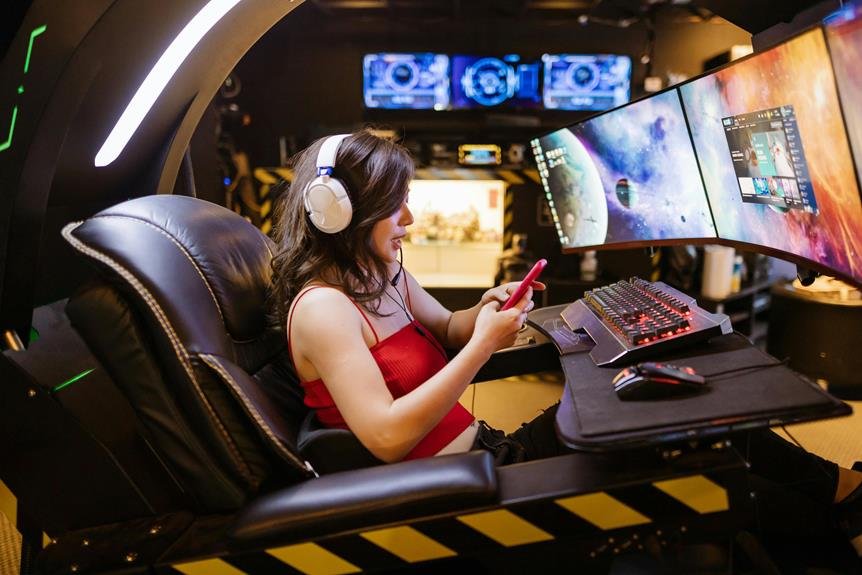
When it comes to elevating your console gaming experience, choosing the right monitor is crucial. From display technology to connectivity options, each aspect plays a vital role in enhancing your gameplay. Imagine immersing yourself in stunning visuals with smooth transitions and lag-free performance. The top monitors for console gaming offer a blend of advanced features to take your gaming sessions to the next level. So, if you're looking to upgrade your setup and optimize your gaming experience, exploring the best monitor options might just be the key to unlocking your full gaming potential.
Display Technology Options
When selecting a monitor for console gaming, consider the various display technology options available to enhance your gaming experience.
One popular choice is LED (Light Emitting Diode) technology, known for its energy efficiency and vibrant colors. LED monitors offer excellent brightness levels and are often more affordable compared to other display types.
Another option is OLED (Organic Light Emitting Diode) technology, which provides deeper blacks and better contrast ratios, resulting in a more immersive gaming experience. Although OLED monitors tend to be pricier, the superior image quality they offer can make them worth the investment for serious gamers.
Additionally, there are QLED (Quantum Dot LED) monitors that combine LED technology with quantum dots to produce a wider color gamut and improved brightness. These monitors are great for gamers who prioritize color accuracy and visual clarity.
Understanding these display technology options can help you choose the best monitor that suits your gaming preferences and budget.
Refresh Rate and Response Time
Considering the importance of smooth gameplay and quick reactions, understanding the refresh rate and response time of a monitor is crucial for console gaming enthusiasts. The refresh rate refers to how many times per second a monitor updates the image on the screen. A higher refresh rate, such as 120Hz or 144Hz, results in smoother motion and reduced motion blur, making fast-paced games more enjoyable.
Response time is the time it takes for a pixel to change from one color to another. Lower response times, typically measured in milliseconds (ms), lead to less ghosting and blurring during fast movements in games. A response time of 1ms or 2ms is ideal for competitive gaming where quick reflexes are essential.
For console gaming, a monitor with a refresh rate of at least 60Hz and a response time of 5ms or lower is recommended. However, if you're a serious gamer looking for the best experience, consider investing in a monitor with higher refresh rates and lower response times for optimal performance.
Resolution and Screen Size
To optimize your console gaming experience, the resolution and screen size of your monitor play a significant role in enhancing visual clarity and immersion. When selecting a monitor for console gaming, consider a resolution of at least 1080p for sharp images and textural details. Higher resolutions like 1440p or 4K offer even more clarity but may require a more powerful console to fully utilize their potential.
In terms of screen size, a larger monitor can provide a more immersive gaming experience, but it's crucial to balance it with your gaming setup and viewing distance. For console gaming, a screen size between 24 to 27 inches is often recommended for an optimal viewing experience without straining your eyes. Larger screens, such as 32 inches or more, can offer a more cinematic experience but might be overwhelming up close.
Ultimately, finding the right balance between resolution and screen size is key to creating an immersive and visually stunning gaming environment for your console gaming sessions.
Connectivity and Additional Features
For optimal console gaming experience, prioritize the connectivity and additional features of your monitor. When choosing a monitor for console gaming, consider the types of ports it offers. Look for monitors with multiple HDMI ports to easily switch between your gaming console and other devices like Blu-ray players or streaming devices. Additionally, having USB ports can be convenient for charging your controllers or connecting other peripherals.
Another essential feature to look for is a low input lag. A monitor with low input lag ensures that there's minimal delay between your actions on the controller and what you see on the screen, providing a smoother gaming experience. Many gaming monitors also come with features like FreeSync or G-Sync, which help reduce screen tearing and stuttering during gameplay.
Other additional features to consider include built-in speakers or audio output options for connecting external speakers or headphones. Some monitors also offer adjustable stands for ergonomic positioning or even built-in blue light filters to reduce eye strain during long gaming sessions. By focusing on connectivity and these additional features, you can enhance your console gaming setup for a more enjoyable gaming experience.




